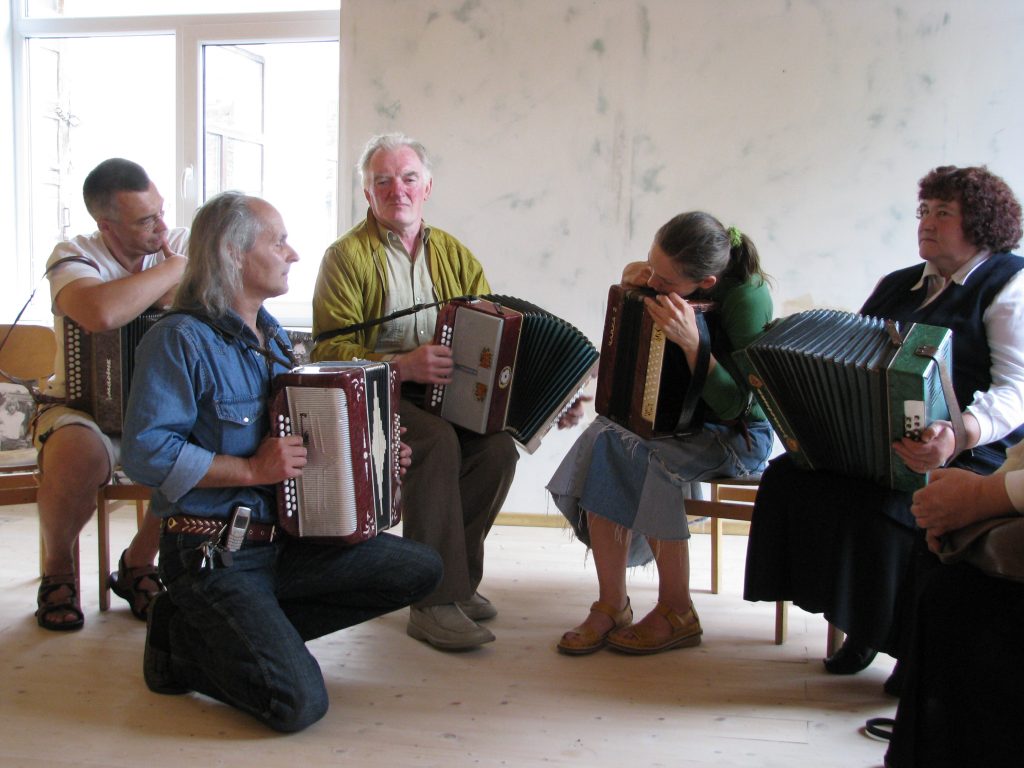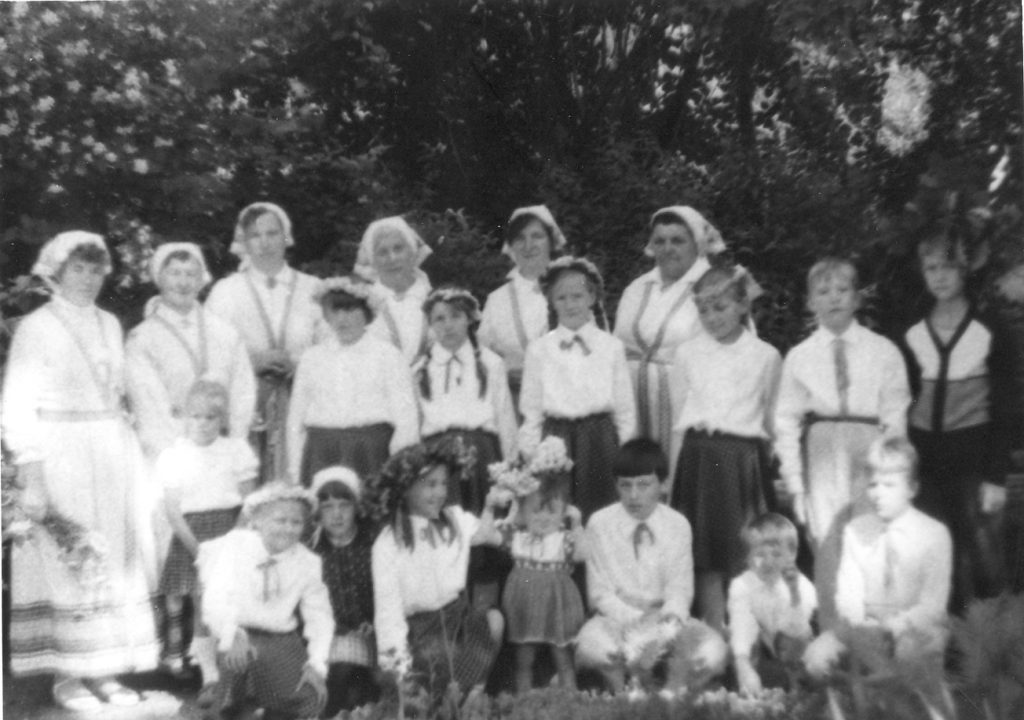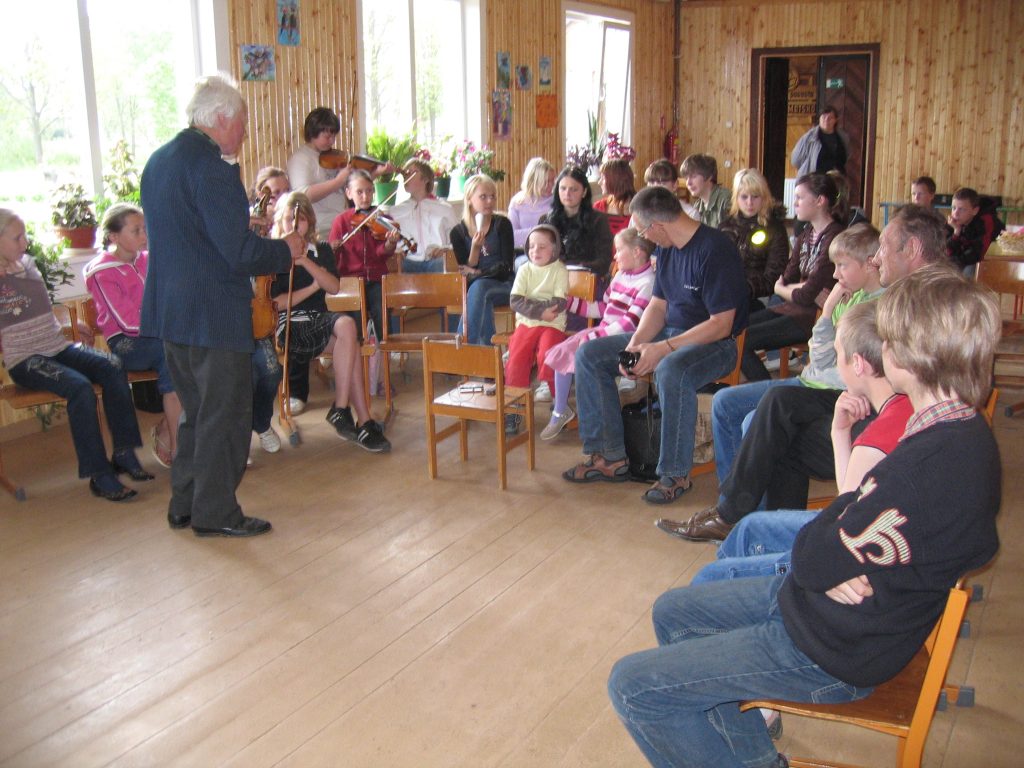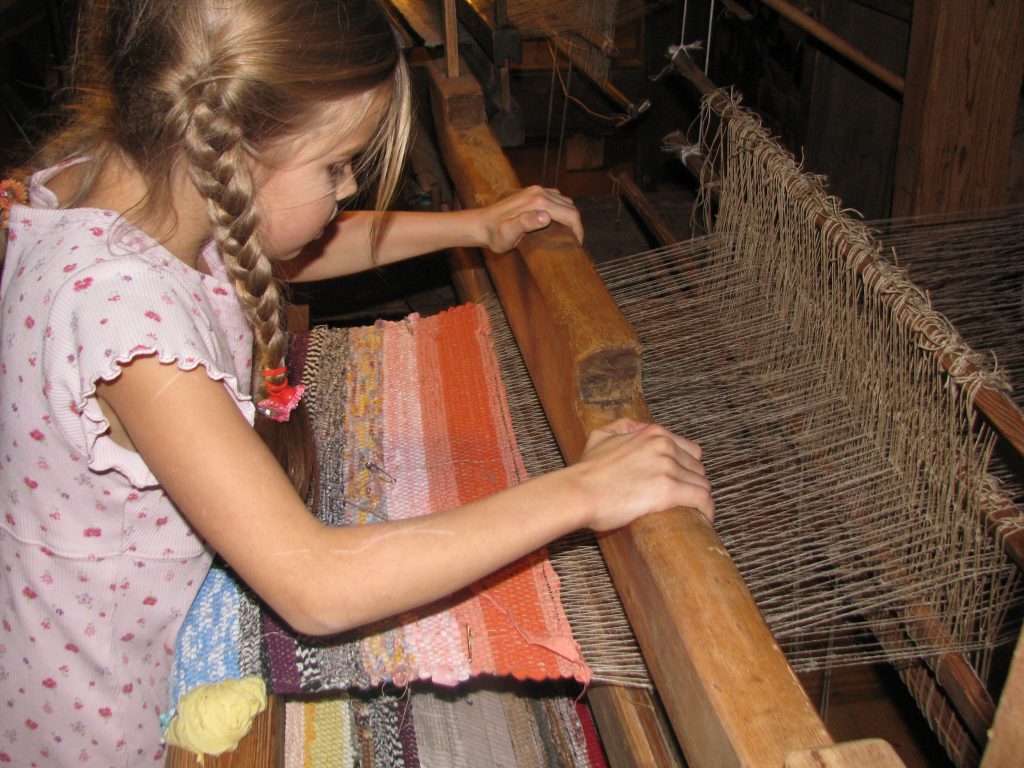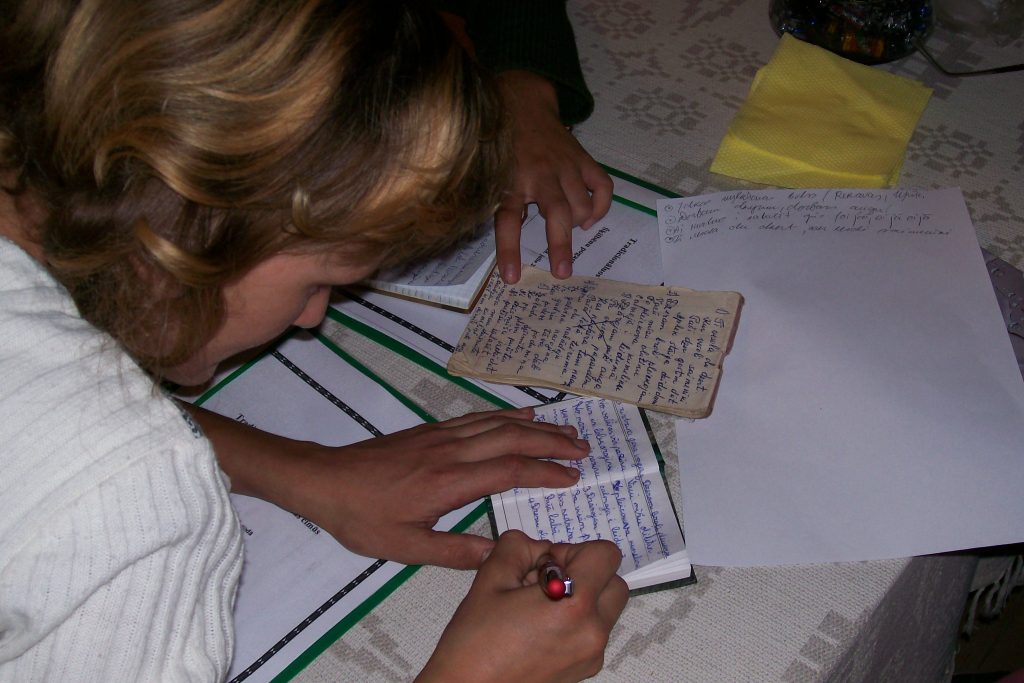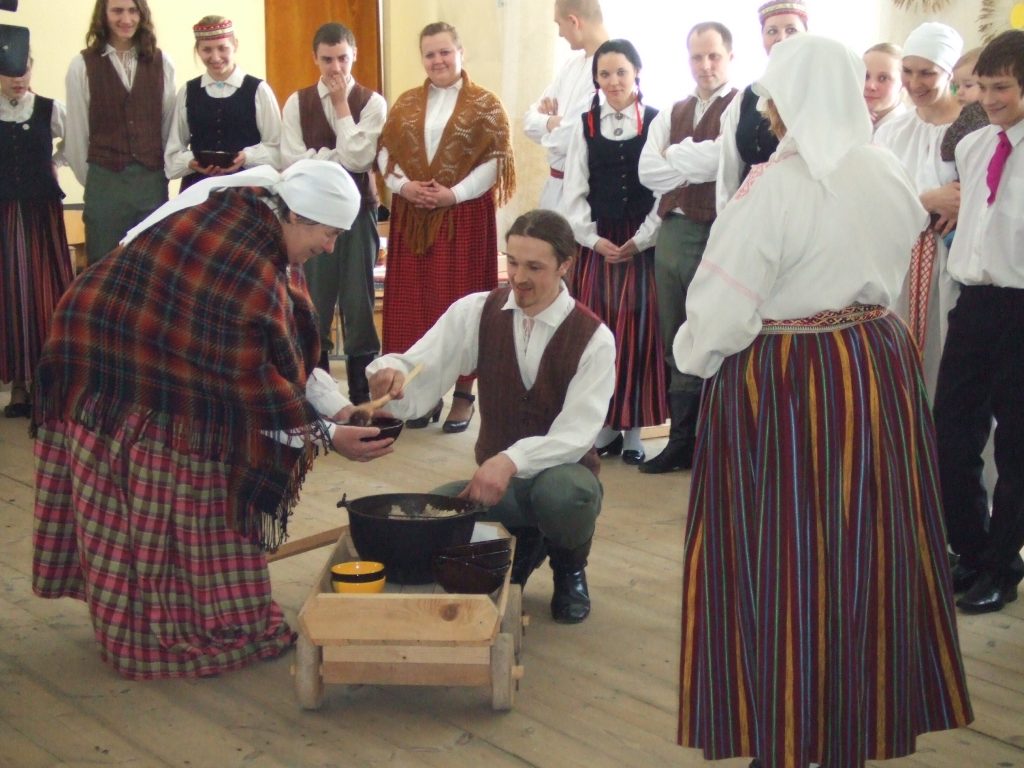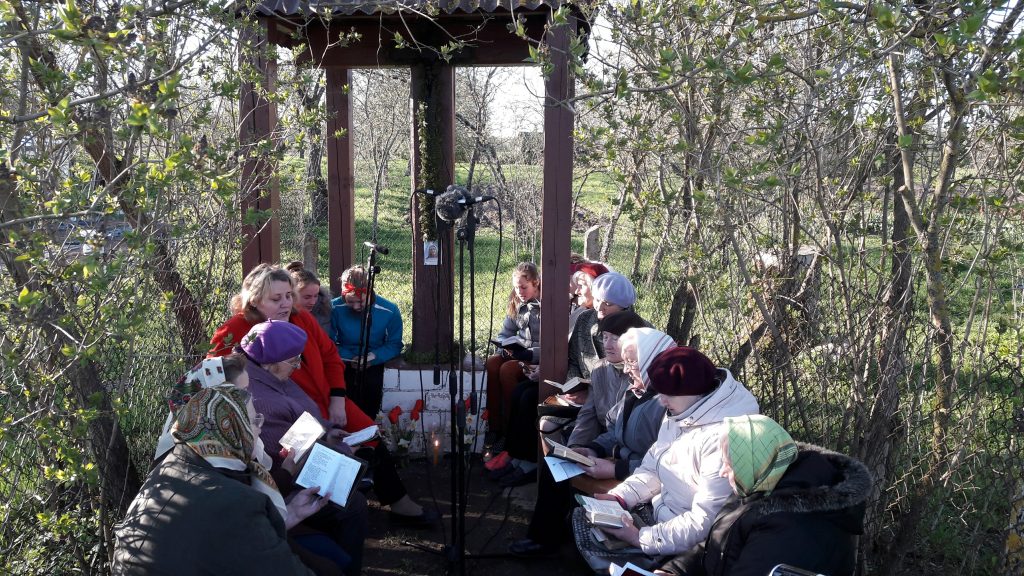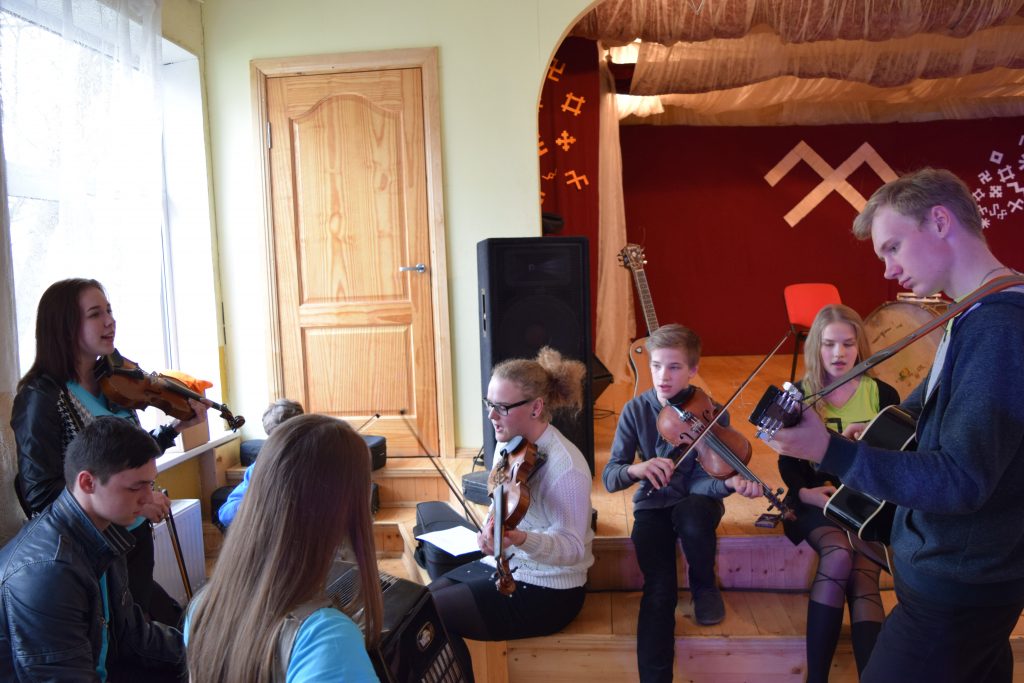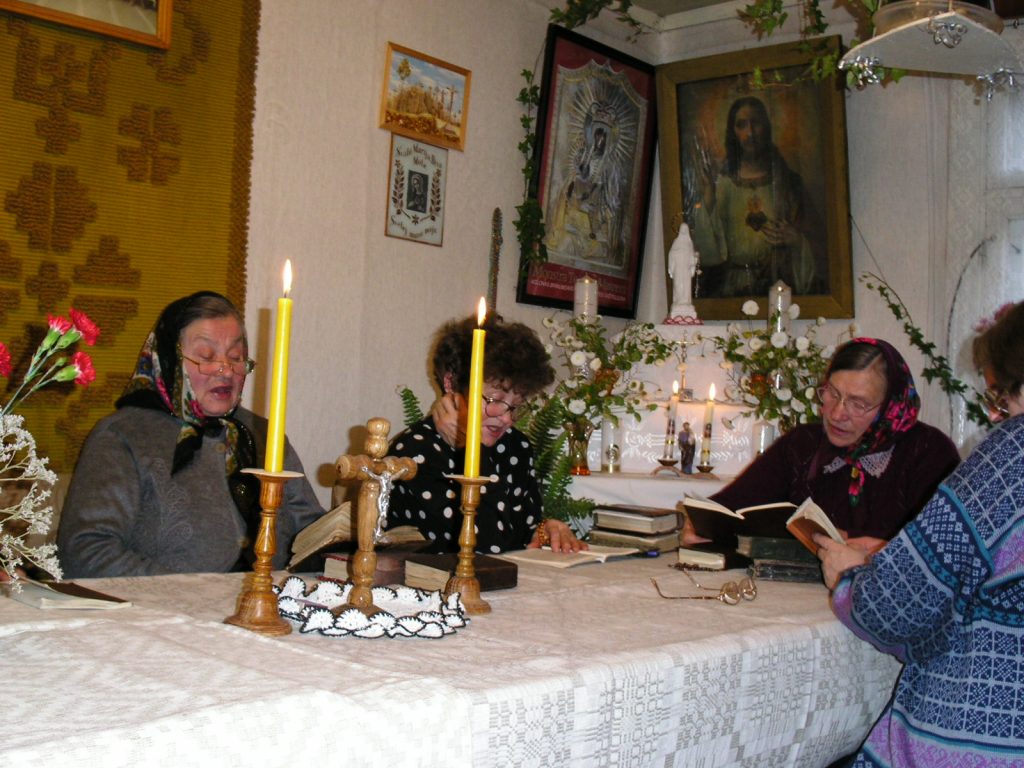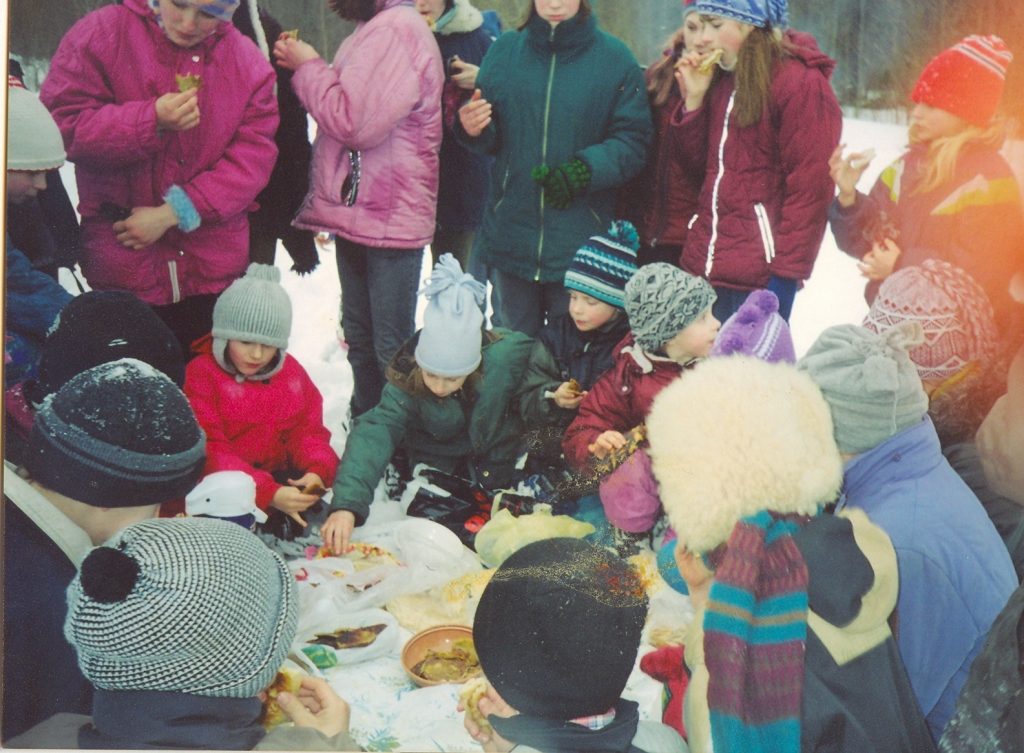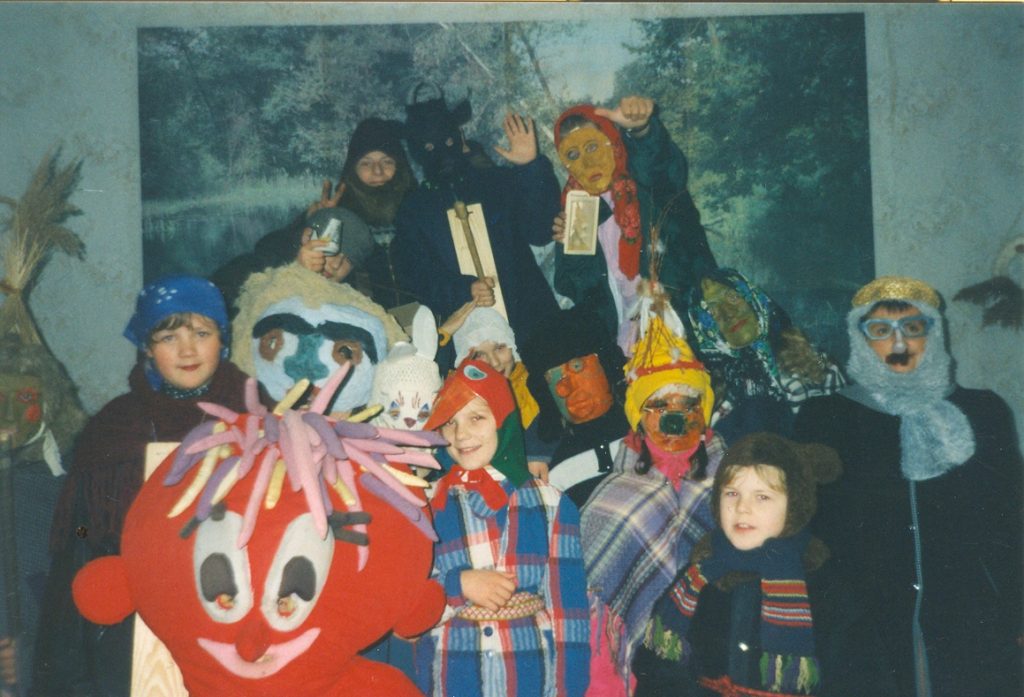Author:
Andris Slišāns
Other domains
Oral traditions and their expressions, including language as a vehicle of intangible cultural heritage
Social practices, rituals and festive events
Music/performing arts
Traditional craft skills
Knowledge and practices concerning nature and the universe
Title
Upīte Cultural Space (2018)
Upīte
Geography
North Latgale.
In 1910, the Zelči village established the Zelči School, which was transferred to Lotuši village in the 30s of the 20th century. The school was located on the banks of the Kūkova River, so it was called the Upīte (river) School. Later, the school was moved to both Grohova and Buki villages, but it always carried the name of Upīte until, in 1981, the central village of a new kolhoz that grew around the school was also named Upīte.
The beginnings of the Upīte cultural space span back to the 1930s, but in the 40s and 50s, with the formation of kolhozes, the foundations were laid for the Upīte village, located in the centre of the original cultural space, consisting of large villages. There, in the aftermath of the war, the surviving Intelligence collected, forming a new, powerful cultural space.
In 1970, Antons Slišāns (Ontons Slišāns) and Miķeļis Jermacāns began collecting church and folk songs by writing them down and recording them on tape.
In the early 20th century, the keepers of the traditional culture began to play an active role, representing three generations: the Upīte Ethnographic ensemble (1980), the Upīte primary school ethnography club and the children's traditional folklore group (1980). In the 90s, the musical rural music group was active, later the traditional folklore group “Upīte” (2002), the Upīte Culture Centre children and youth music group (2011).
The folklore consciousness and the cultural space care centre have been a family of Slišans throughout this time: Father Anton (Onton) Slišāns (28.12.1948-15.12.2010) was a foundle of folklore movement in this area, idea generator, project manager, patriot, counselor, his wife Irene Slišāne (b. The Vizule (16.5.1952 –18.05 .2018) took care of the transfer of traditional culture to future generations, since 1982, involving pupils in folklore movement, traditional cultural maintenance and making processes, the older daughter Annele Slišāne continues the craft of crafts, more specifically the tradition of weaving traditions, taking over and learning the skills of traditional positions, and creating new textile art works that interpret the skills and heritage of the ancient generations with modern art processes and actuarial events, son Andris Slišāns is the continuation of the folklorist movement of his father and mother in the cultural space of the river, an active dancing tradition successor, the organiser of the upstream cultural life, organising all events of Latvia that attract folklorists, literates and musicians from various municipalities and cities, his wife Ligita Slišāns is involved in the cultural processes of the river since 2008, and his wife Ligita Slišāns is involved in the cultural processes of the River since 2008, and his wife Ligita Slišāns is involved in the cultural processes of the River since 2008, and his wife Ligita Spridzane is involved in the cultural processes of the River since 2008.
Much of the maintenance and development of the Upīte cultural space has been given by the Upīte Primary school, which is studying, learning, inheriting and developing the traditional culture since 1980 – mostly in the shool's Etnographic club.
At the moment, the central location that maintains, contains and forms the Upīte cultural space while promoting the old values and the modern cultural processes in local residents and guests of Upīte is the “Upīte” centre of intangible cultural heritage. It has three departments: the Upīte People's House, the Upīte library, the Ontons Slišāns Upīte Cultural History Museum.
30 skill bearers and masters are active in the Upīte cultural space. It is a way to maintain a living heritage and to transfer it to future generations in Upīte itself, as well as the larger area: North Latgale, Latgale, Latvia.
Significance in community life
The foundation of the Upīte cultural space consists of local folklore and artisanal heritage, its identification and learning from recordings, written materials, storytellers, and excellent old crafts masters.
This live tradition is currently formed as the co-operation of three generations and is mainly organised by the Intangible Cultural Heritage Centre “Upīte” and local folklore collectives: the Upīte Etnographic ensemble (50–85 year old participants), the traditional folklore group “Upīte” (15–40 year old participants), the Upīte children traditional folklore group (2–15 years).
Each collective works separately, but at the same time, by inheriting traditions, the middle generation learns from the eldest, and younger from the middle generation.
Meanwhile, the younger and middle generation, with the active support of Ligita Spridzāne, are exploring the local folklore records that have been collected and found in various sources, and meets with local experts, studying local historical song types and manners of singing such as tolku bolss, pusbolss, zagiuze bolss/spring bolss, the autumn bolss/ wedding bolss, the kaladuošona, the rūtuošonu, etc.
Activities
1. In Upīte, the tradition of spiritual singing is alive and cultivated, including May Devotional Singing at Wayside Crucifixes and the singing of “saļmes” for the dead. Every year, May devotional singing is held at the wayside crucifixes, where the older generation is in the leading role, but the younger generation is engaged and singing with them, becoming the successors of this tradition in the future. These traditions are not theatrical performances or demonstrations, but still alive. In the same way, singing saļmes for the dead is cultivated, the youngest generation inheriting the tradition from the older generation of wives. In this way, the live folk tradition, which has remained from previous generations, is still being passed on and is a benefit to the cultural space of Latvia and the world – a good example is the concert of Spiritual songs in the Riga cathedral during the XXVI's Latvian song and XVI dance festival of July 2018, where singers from Upīte, including young people, sang Zechariah's song.
2. An important part of the Upīte cultural space is the traditional festival of poetry “Upītes Uobeļduorzs” (Upīte apple garden), which has been held every year on the third Saturday of September and gathers Latgalian-language lovers, poets, musicians from all Latvia since 2002. The festival is visited by people of different ages, each finding something important, sweet and special for their soul. It hosts Latgalian poetry and the music of all styles in Latgalian language – from folklore to hard rock, making this event one of the most important events of Latgalian culture. The festival has twice received the Latgalian Cultural annual award “Boņuks” as the best event in a Culture or People's House.
3. The modern cultural environment of Upīte is largely made up of the rehearsal life of traditional folklore groups, as both young women and men, and children meet together. While girls sing, the boys discuss their things, and the children can directly hear melodies and “bolss”, until they realize at one point that they already know the melodies and the words and sing along. During the rehearsals, dances and dancing games are also performed, and children and men also join along for them. The cultural environment of Upīte is also composed of informal events organised by members of folklore communities outside of rehearsals, such as the “Agruos pušdīnes” game, in which once a week, on Sunday, everyone meets one of its participants and enjoys the traditional food of these houses, later voting for the best feast.
4. An integral part of Upīte cultural space is the folk musicians, they participate in events organised by the People's House, play both in an informal environment and dancing workshops, they can play the necessary melody and improvise, also sing, jump along with the dancers, and dance in a smooth dance step. In addition, the generations of the Upīte musicians are young, only 13–30 years old, but they can already be called folk musicians, because all melodies are being learned by listening and playing with them.
5. Other cultural work enthusiasts and those curious of the Latgalian cultural space are arriving at Upīte from other areas of Latvia to meet people, talk, share their experiences – they come to feel like home, come to weave on the looms, come once and want to come more and more, attracted by both the place and the people, the affection and the feeling of the home.
6. In Upīte, ever since 1980 an environment that is attractive for children and young people has been created and cultivated. We share our knowledge with those who come to visit us by teaching dances, games, songs, crafts. We celebrate annual festivities: Meteņi, Easter, Summer solstice, Miķeli, Winter solstice.
7. The wealth of the Upīte cultural space is collected by the North Latgale Latgalian dialect (Upīte, Šķilbēni areas), because everything happens in Latgalian here. The process of forming the Latgalian literary language has been taking place for several centuries, with the Latgalians participating since 1908, when the first Latgalian grammar book “Latvīšu volūdas gramatika” by Antons Skrinda (Ontons Skrynda) was issued in St. Petersburg. The language spoken in Central Latgale was chosen as the basis of the Latgalian literary language, also in 2007 the “Latgalian language spelling rules” approved by the Cabinet of Ministers correspond to the language used in Central Latgale and part of South Latgale. Unfortunately, the specificities of the North Latgale language are sometimes only allowed as parallel forms, but mostly they remain only in oral communication, thus contributing to the forgetting of the oldest forms.
Thanks to Antons Slišāns's enthusiasm and passion, the language heritage of North Latgale is still topical, he has continued the identification of the folklore texts of his native land, incorporating them into the folklore repertoire, using old word forms and words in his own literary creative works.
This is why it is now safe to say that, as in Germany, where there is a Bavarian dialect with its own peculiarities, so that in Latvia, alongside the Latgalian literary language, there is vibrant of Northern Latgalian dialect, which is found in A. Slišāns's works and in the activities of the Upīte traditional folk group: the collecting of songs, the singing, the inheritance of traditions and the transfer. In the standartisation of the Latgalian literary language, individual sounds and word forms are changed, but in folklore texts, also in A. Slišāns creative work, these are very important details that can change the sound of the poetry or the sound of the song melody. The preservation of the northern Latgalian dialect is important, so that the everyday communication in Upīte does not lose its own peculiar details.
Passing on and transferring skills
Upīte is the only region in North Latgale where the old games and dances are so widely known, explored, preserved, developed and handed over to the younger dancers by the local population because Antons Slišāns's dedicated work since the 70s and 80s this exploration has been of an organized and targeted nature, not a chaotic self-activity, but a sense of heart and responsibility of local cultural roots and the process of shaping the modern cultural space.
This process is carefully coordinated and organised by exploring, studying, restoring ancient traditions and creating educational materials for their acquisition by organising and managing master classes in a near and far, regularly organising dancing activities.
If, by 1980, the dances were only in our grandmother's memories, when they were danced at dancing events, open air balls and parties, then, from 1982, Irēna Slišāne, with the children of the school's ethnographic club, drove on expeditions to the elderly locals who still knew the dances and revived the old dances – they are now widely known throughout Latvia.
At the beginning of this century, the Upīte youth traditional folklore group, now grown up to be the Upīte traditional folklore group, began a new phase in the acquisition of both the inherited dances and the polyphonic songs (Upīte is the place where the youngest person to know how to sing the pusbolss lives – Kate Slišāne, who is 17 years old).
We have inherited dances from grandmothers, they are taught to children. There have been an estimated five generations of school-age children who have both participated in the annual celebrations: mask parades on Mārtiņi, Christmas and Meteņi, Easter celebration at Lotušu Linden and the Upīte Oak, midsummer eve, midsummer day and Miķelis day traditions, and learn, and learned the characteristic traditional folk songs and dances of the Upīte area.
History
The cultural environment of Upīte can be divided into several eras:
• Until the time of the Soviet occupation, almost every household had a weaver, a knitter, a seamstress, a craftsman, a lead singer, a dance-knower, a musician. There was a crucifix in each village, where the whole village sang the May devotional singing together. All festivals, collective working and annual traditions were sung and danced in “večerinkas” or open air dance parties;
• Occupation era. Until the 1970, the number of knowledge-bearers, musicians, craftsmen, dancers decreased sharply. This was facilitated by the shrinking of the population due to the Second World War, the deportation to Siberia, the collectivisation and the escape of the population to cities, as well as the change in collective thinking, which was facilitated by the denial of the old heritage, the various prohibitions of Soviet life, the mocking of the past, the praising of a new life rooted not in the local culture but brought from the central power;
• The Antons Slišāns era. In the early 70 s, Early in the 1970s, Antons Slišāns and his uncle from his mother’s side Miķelis Jermacāns (Jākubtāvs) realized that if no action was taken, the intangible heritage of the area would disappear. Because of this, they recorded on tape folk songs and sacred songs sung by Antons’ mother Anna Slišāne, Katrīna Jermacāne and other women of the area. In 1980, Antons Slišāns lead the foundation of the ethnographic ensemble in Rekova and in Upīte a couple of weeks later. The first concert of both ensembles took place on 2 August 1980, which is also regarded as the date of its establishment. In the autumn, the schoolchildren were gradually involved in the singing of the traditional folk songs. From 1982 Irēna Slišāne worked to involve children and youth in traditional culture processes. Over the span of 32 years, she has raised at least six ensemble cohorts. The women of the Upīte ethnographic ensemble were powerful singers; simultaneously massive, unselfish work with children was started, and in those years, Upīte maintained a leading role in the inheritance of intangible cultural heritage in North Latgale;
• Intensive work era. From 2000 to 2010, Antons worked with the older generation, Irēna with the younger generation, and Andris and Ligita with the medium generation. In 2007, a project was launched: “The annual school of passing down traditional culture in Upīte”. This marked the beginning of a new, intense and rapid change in the field of traditional singing, dancing and music making;
• In 2010 Antons Slišāns passed away, but even more intense and focused work began as the people understood his invaluable contribution to the birth of the Upīte cultural space;
• 2011 marked a new stage in the traditional music making field began, gradually forming a rural traditional music group of young musicians who learned music making by learning to play by ear. The old polyphonic songs recorded by Antons, which had been lying in old, untouched tapes since the 1970s were revived, and album Upīte area traditional folk songs was issued, with the songs of three and four vocal parts, including singing with a half-bolss. There was also intense work on the exploration and promotion of dances, dance-games and games; as a learning tool, a dance DVD was issued. The traditional folklore group Upīte began actively performing outside Latvia's borders – Poland, France, Lithuania, Czech Republic, Romania, Italy (Sardinia);
• In 2017, the First international folklore dance festival “Lipa kust” was held in Northern Latgale, organised by the association “Upīte youth traditional folklore group”, the central location of the festival was a Upīte, also including Baltinava, Rekova and Semenova.
Since the 1970s, the role of Upīte in the research, preservation and promotion of intangible cultural heritage is to be the first, most active, to be leaders – carriers of the torch.
Masters
• Aija Korneja (b. Šakina) (Upīte) – storyteller, expert of games and culinary heritage;
• Andris Ločmelis (Briežuciems) – craftsman (leather crafts);
• Andris Slišāns (Upīte) – expert of traditional dances;
• Anna Keiša (b. Slišāne) (Upīte) – the expert of the spiritual songs, singer, storyteller, the May singer at the cross;
• Annele Slišāne (Zelči) – artisan, artist, weaver;
• Daiga Keiša (b. Gabrāne) (Bokova) – storyteller, expert of traditional dances;
• Daina Slišāne (Stabļova) – storyteller, expert of traditional dances;
• Dāvis Slišāns (Komugreiva) – expert of traditional dances, whistle master;
• Dina Krakope (b. Vizule) (Stabļova) – storyteller, craftsman, expert of the culinary heritage;
• Domeniks Slišāns (Upīte) – folk musician, storyteller, expert of traditional dances;
• Ilgvars Keišs (Baltinava) – folk musician, craftsman, carpenter;
• Inese Matisāne (b. Liepiņa), (born in Saulkrasti, living in Upīte) – storyteller, expert of culinary heritage;
• Irēna Romka (Mukaušova) – artisan;
• Irmina Slišāne (Stabļova) – singer, a May devotional singer at the cross;
• Iveta Logina (b. Kudrjavceva) (Dubļova) – singer, a May singer at the cross, craftsman;
• Kate Slišāne (Upīte) – singer, folk musician, storyteller, expert of traditional dances;
• Liene Logina (Baltinava) – folk musician;
• Lienīte Slišāne (Upīte) – craftsman, artist;
• Ligita Spridzāne (born in Šķilbāni, living in Upīte) – storyteller, expert of traditional dances, weaver, braider;
• Līvija Supe (Stabļova) – singer of pusbolss, storyteller, a May singer at the cross;
• Lolita Spridzāne (Šķilbani) – weaver;
• Malvīne Romka (Mukaušova) – craftsman, weaver;
• Mārīte Slišāne (Upīte) – expert of culinary heritage;
• Monika Keiša (b. Tabūne) (Upīte) – storyteller;
• Nataļja Putniņa (b. Kondratjuka) (Dubļova) – storyteller, expert of traditional dances;
• Renārs Kornejs (Upīte) - expert of traditional dances, beekeeper;
• Rolands Keišs (Baltinava) – folk musician;
• Sandra Bukša (Stabļova) – craftsman, artist, expert of the culinary heritage;
• Valentīna Keiša (Pakašova) – storyteller, singer, a May singer at the cross;
• Zintis Krakops (born in Bukas, lives in Tilža) – folk musician.
Agencies and institutions
The association “Upīte Youth Traditional Folklore Group”, the “Upīte” Centre for Intangible Cultural Heritage, Balvi municipality council.
Consolidation
Progress made in the past 5 years to ensure the existence and continuation of the element:
• Balvi municipality Intangible Cultural Heritage Centre “Upīte”:
a) Digitised the folklore collection of Ontons Slišāns and Miķelis Jermacāns gathered in the 1970s;
b) Restored 10 tales, read by Ontons Slišāns all of which are recorded, and can be heard here: https://www.upite.lv/puosakas/ A book of fairy tales is now being prepared;
c) In collaboration with ZS “Jākupāni”, a folk costume workshop has been established, the main selling point of which is the acquisition of a digital loom. We have examined the traditions of wool blankets in two symposia of textile artists and have begun restoring these blankets;
d) Festival and seasonal festivity traditions have been preserved and grown. Despite the limitations of the COVID-19 pandemic, we have not skipped a year for the festival “Upītes Uobeļduorzs”, the summer solstice celebrations, Easter, the children and youth folklore festival of the Kūkova county, the masking traditions – going “gypsy”, carnival;
e) We have performed field studies – recorded interviews with the women of the Upīte ethnographic ensemble, with approximately 3-4 h long interviews in both audio and video format with each of the women.
• “Upītes jauniešu folkoras kopa” association:
a) We continue, develop and organise the international folklore festival “Ļipa kust”; it was held in 2019 and 2022;
b) The society has acquired the closed Upīte primary school building, this building is being converted as an idea residency for young people:
i. We have created a professional sound recording studio – Bigmaar's Record;
ii. A traditional folk costume studio has been established;
iii. An educational poetry and intangible tradition inheritance game “Pīci panti” has been created and was added to the “School bag” programme.
c) We created and maintained a website upite.lv of the Upīte cultural space, which also contains such sectons as “Masters”, where there is brief information about the various masters of the Upīte cultural space, as well as the “Searching for masters” section where the masters teach their skills in a fun video;
d) We have set up a number of educational tourist routes in video format in the Upīte cultural space and its surrounding areas – 9 walks in total, see here: https://www.upite.lv/pa-paduom/.
• Traditional folk group “Upīte”:
a) The group has created the activity “traditional Northern Latgale games and dance-games” and is offering it to to schools through the “School Bag” programm;
b) Two new albums have been released – CD “Ryugts” – Upīte area wedding songs, and the CD “Padzīdam i…” – mens songs of the Upīte area; for 6 of these 17 songs professional videos have been created and can be seen here:
https://www.youtube.com/watch?v=F1N8Ix0IuwY&list=PLQ4kkAXBt141kAJHjjX6H9gMXlPdfszd1;
c) Together with the Upīte ethnographic ensemble women we are singing saļmes (psalms) at least 2 times a year;
d) Together with the Upīte ethnographic ensemble women, we have recorded 10 songs, which are planned to be issued in the near future;
e) We are regularly participating in various international folklore festivals in Europe where we can gain new experience, of course by this action, we are attracting new participants, new advocates of the Upīte cultural space.
• Children’s traditional folk group “Upīte”:
a) Participated in Latvian youth song and dance festivals, as much as the restrictions on the pandemic allowed;
b) A generation of new musicians has developed;
c) Regularly participates in the folklore competitions organised by VISC and organized in “Pulkā eimu, pulkā teku.”
The name and operation of the Upīte cultural space has become even more recognisable, which attracts young people wishing to participate. The list of the aforementioned works, as well as a list of many minor unmentioned works creates self-confidence and patriotism for the place and its values. The group explores, maintains, learns, modernises and promotes the operation of the Upīte cultural space and its vitality. The active work has been noticed and appreciated: 1) The traditional folk group “Upīte” has received the Latgalian cultural award “Boņuks” and the audience award “Žiks” for its activities in 2020 and the album “Padzīdam i…”; 2) The breakout game “Pīci panti” received the “Boņuks 2021” award; 3) Andris Slišāns has been awarded Officer of the Order of the Three Stars in 2020; 4) Ligita Spridzāne was awarded the Nikodems Rancāns Prize in 2022 for teaching folklore at school.
The received and planned support of state and local government institutions:
• In these five years, there have been 3 cooperation agreements with the Latvian National Culture Centre, which has financed various events, album release, book publishing, purchase of musical instruments with a total funding of EUR 30000,00;
• The Latvian State Culture Capital Foundation finances the activities of the society as part of its support of professional NGOs. There have been two projects supported by the SCCF, which finances those organisations that maintain intangible heritage values that are included in the national list, total funding of EUR 44435,00.;
• In addition to both the SCCF and the LAD LEADER projects, we have implemented more than 20 projects during these years, with a total funding of more than EUR 150000,00;
• The State Investment Plan supports the project “Development of municipal infrastructure by improving the efficiency of services in the Upīte cultural space” within which the building of the intangible cultural heritage centre “Upīte” will be fully reconstructed and restored, in addition to the creation of a modern exhibition hall and a museum fund space conforming to all requirements. Total funding 900000,00EUR;
• In the future, we will also be able to collaborate with the Balvi county council, LNKC, SCCF, LAD LEADER, EU LAT-LIT Interreg programmes;
• We place great expectations on the Law on Historical Regions of Latvia and its council, expecting both financial and moral support.
Continuation/development
Measures to be taken to promote the element's visibility over the next 5 years:
• Balvi municipality Intangible Cultural Heritage Centre “Upīte”:
a) A catalogue of digitised Ontons Slišāns and Miķelis Jermacāns recordings was created and structured;
b) By the anniversary of the Upīte ethnographic ensemble in 2025, a book about the ensemble will be published.
• “Upītes jauniešu folkoras kopa” association:
a) The website for upite.lv will be improved, placing emphasis on the identification and promotion of the masters of the Upīte cultural space.
• Traditional folk group “Upīte”:
a) Studying the legacy of the kolhoz – songs. These songs will be restored and recorded;
b) the vast heritage of spiritual songs will be explored: we will study, restore and record fasting songs.
The main measure for the protection of the cultural area is the person, the Community and a set of traditions which are inherited, developed and perfected. Establishing this as the main goal of the protection and development of the Upīte cultural space, the following measures are to be taken.
• Balvi municipality Intangible Cultural Heritage Centre “Upīte”:
a) Complete reconstruction of the building will be carried out;
b) A digital and tangible exhibition will be created on the Upīte cultural space and all other values included in the Latvian intangible heritage list;
c) We will continue to organise and develop traditional celebrations, festivals;
d) The book by O. Slišans, M. Slišāne, J. Slišāns “Tuo jī dzeivova zyli, zaļi…”. is being prepared to be published in 2023.
• “Upītes jauniešu folkoras kopa” association:
a) We will continue to organise the international folklore festival “Lipa kust”. Next planned 2024, 2026, 2028;
b) We will continue to develop a Upīte school building. We plan to create a weaving studio and a culinary heritage studio;
c) We will improve the online store section of the upite.lv website, where you can purchase the items made by Upīte artisans and acquire their services;
d) Promote the gradual change of generations, which will clearly contribute to the protection and development of the element;
e) Strengthen the Community by creating a variety of educational and connection-building activities.
• Traditional folk group “Upīte”:
a) Participation in Latvian song and dance festivals, festival “Baltica”;
b) We will not be afraid to experiment with the tradition, thus creating new ones;
c) Participate actively in European international folklore festivals;
d) We will reestablish the “Agruos pušdīnas” game, which was, unfortunately, affected by the constraints of the pandemic; we will continue promotion of the culinary heritage.
• Children’s traditional folk group “Upīte”:
a) Participation in both the general Latvian song and dance festival and the Youth song and dance festival;
b) We will regularly participate in the folklore competitions organised by VISC and in “Pulkā eimu, pulkā teku” event.
The objectives of these measures:
• Maintain as to not lose;
• Promote to attract new people;
• Enable young people to take responsibility;
• Develop and strengthen the sense of community belonging to the Upīte cultural space;
• Study and document to avoid shallowness.
Threats
Since 1 September 2018, the Upīte primary school has been closed, thus terminating the usual work with children in etnography club and children folklore group. However, the work with children does not stop because the children's traditional folk group continues to operate under the wing of the Intangible Cultural Heritage Centre Upīte and attracts new members.
In modern Latvia, there is a depopulation in rural areas, a sharp decline in population due to the people moving to larger population centres and abroad. However, the very intensive cultural life in the Upīte region is a way to contribute to the preservation of the population, as the desire of the population to remain in the lands of their ancestors is determined not only by economic factors, but more by the sense of belonging to their recognised cultural space that was created by their parents and themselves.
Applicant
Andris Slišāns, association “Upītes jauniešu folkloras kopa”, Reg. No. 50008155851
Image Gallery
Audio Materials
Video
Text Materials
Publications
Beitāne, A. (2009). Vēlīnās izcelsmes vokālā daudzbalsība latviešu tradicionālajā mūzikā. Rīga: UL Institute of literature, folklore and arts.
Boiko, M. 1991. Ziemeļlatgales burdondaudzbalsība: konteksts un struktūras. Manuscript. Riga: Jāzeps Vītols Latvian Academy of Music
Boiko, M. 2012. “Mirušo ofīcijs (saļmes) Latgalē / The Office of the Dead (saļmes) in Latgale”. In Psalmu dziedāšana Latgalē. Officium defunctorum. The Office of the Dead in Latgale. Aigars Lielbārdis (sast.). Rīga: UL literature, folklore and arts institute, 14-46.
Boiko, M., Gita Lancere, Anda Beitāne. (2008). Latviešu tradicionālās mūzikas antoloģija / Anthology of Latvian Traditional Music. Riga: UL literature, folklore and art institute.
Boiko, M. (2001). „Mirušo ofīcijs (officium defunctorum) un sapņu folklora Dienvidaustrumlatvijā“. In: Materiāli par kultūru mūsdienu Latvijas kontekstā. Riga: Zinātne: 69-105.
Boiko, M. (2001). „Psalmu dziedāšanas tradīcija Latgalē.“ In: Acta Latgalica. Zinōtniski roksti, dokumenti, apceres. 11. sēj. Daugavpiļs: Latgolas pētnīceibas instituta izdevnīceiba: 348-377.
Boiko, M. (2002). „Tikšanās ar mirušajiem sapņos: tipizēti un netipizēti stāstījumi un to funkcionālie un kultūrvēsturiskie konteksti.“ In: Agita Lūse (red.)Cilvēks. Dzīve. Stāstījums. Rīga: Latvian anthropologist association, University of Latvia Literature, folklore and art institute: 115-125.
Boiko, M. (2004). „Nāve, rudens, sapņi un mirušo ofīcijs Latgalē.“ Mūzikas Saule, 2004 Nr. 5 (25): 24-27.
Cibule, R., Anda Beitāne. (2015). "Nemateriālais kultūras mantojums teorijā un praksē. Ziemeļlatgales pieredze". Nemateriālā kultūras mantojuma saglabāšana: Latvijas pieredze. Rīga: UNESCO Latvian National Commission, Latvian National Cultural Centre.
Kranenborg, A. (1999). Het Lied van Valentina, 1999, one of the seven films in the series Lied van verdriet (Songs of sadness).
Slišāns, A. (2016). Folkloras kūpa Upīte. Dzīduot muoku, doncuot muoku. Rūtaļu un daņču aproksti. Rēzekne: Latgales producentu grupa.
Slišāns, O. (2004). “Jāņi Latgalē / Juoņi Latgolā”. In Praktiskā Jāņu grāmata. Aīda Rancāne (sast.). Riga: National Agency “Tautas mākslas centrs”, 76-81.
Slišāns, O. (2012). “Saļmu dziedāšanas tradīcija Upītē / Singing of the Office of the Dead in Upīte”. In Psalmu dziedāšana Latgalē. Officium defunctorum. The Office of the Dead in Latgale. Aigars Lielbārdis (sast.). Riga: UL literature, folklore and art institute, 47-56.
Slišāns, O. (2010). “Čipierksneits jeb apcirsto sakņu pieaudzēšana”, Rēzekne, ZS Jākupāni
Beitāne, A. 2012. “Multipart Singing in Northern Latgale: Dynamics of Tradition in the Late 20th — Early 21st Century”. In Res Musica, Nr. 4/ 2012, 125–143, ISSN 1736-8553.
Beitane, A. (2018). Notes from Latvia. Multipart Music in the Field. Vienna: Department for folk Music Research and Ethnomusicology of the University of Music and Performing Arts Vienna/Riga: Joseph Vītols Latvian Academy of Music.
Boiko, M. (1998). “Relics of Burial Laments in Latvia”. In: Jukka Louhivuori (ed.) Finnish Yearbook of Ethnomusicology 1998. Special issue: Conference Proceedings of the European Seminar in Ethnomusicology 1997. Helsinki: The Finnish Society for Ethnomusicology: 152-162.
Boiko, M. (2005). „Totenoffizium, Jesuiten und heidnische Seelenspeisungen in Südostlettland.“ In: Heike Müns (Hg.) Musik und Migration in Ostmitteleuropa. Schriften des Bundesinstituts für Kultur und Geschichte der Deutschen im östlichen Europa, Oldenburg. Bd. 23. München: R. Oldenburg Verlag: 61-79.
Boiko, M. (2010). “Da lattgallische Totenoffizium.” Zu seiner gegenwärtigen Lage. 'In: Rolf Bader, Christiane Neuhaus und Ulrich Morgenstern (Hrsg.) Concept, experiments, and Fieldwork: Studies in systematic Musicology and Ethnomusicology. Frankfurt am Main: Peter Lang: 369-380.
Websites
http://www.balvurcb.lv/kb/ - The database contains records of all collectives working in the Upīte cultural space, about the local experts, the folk musicians, the major events. Each record is accompanied by a link to a list of sources in a local history collection database, which is a bibliographic information database on newspaper articles, books, and other publications. For example, there are 28 publications from the newspapers “Vaduguns”, “Vietējā Latgales avīze”, “Viļakas novadā” and “A12”, or, by entering the name of expert Valentīna Keiša, a number 10 entries from the newspapers “Vaduguns”, “Vietējā Latgales avīze”, “Izglītība un Kultrūra”, “Kultūras forums”.
https://youtu.be/_E_619U59lI - Latgale regional TV story of the solstice tradition in Upīte.
https://youtu.be/T6m4rA3UA7A - Latgale regional TV story of the festival “Lipa kust”
https://youtu.be/7Xg7KrOJIcw - Latgale regional TV story of the festival “Upītes Uobeļduorzs”
https://youtu.be/tVupIPuTf_M - RETV programme “Latvian stories. Personalities'

